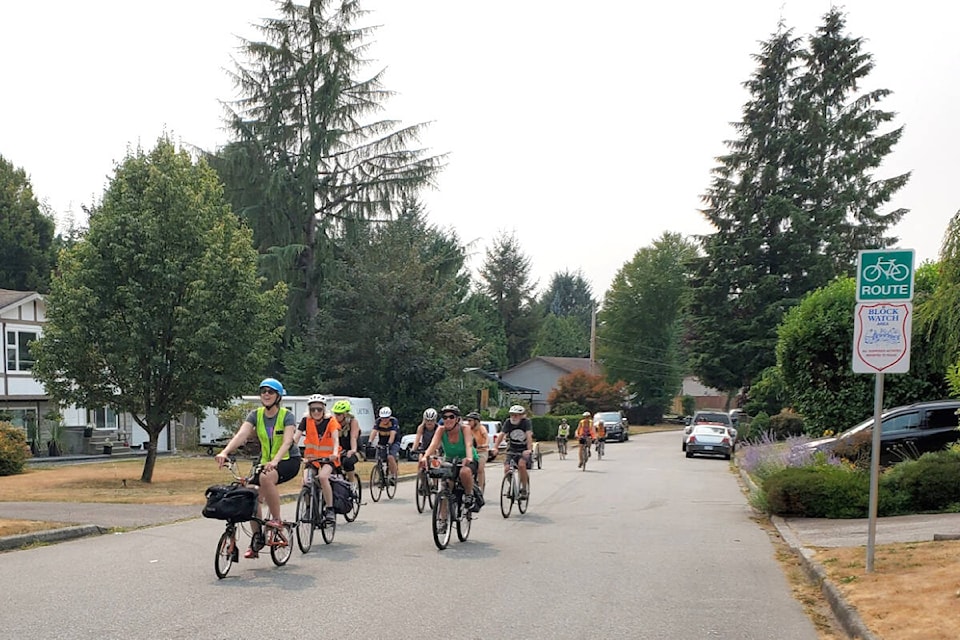By Jackie Chow/Special to The News
The City of Maple Ridge is creating a bold new vision for transportation in our city.
It’s our chance to rethink how we accommodate the transportation needs of everyone and address climate change at the same time.
Here’s what we know. Sixty per cent of climate-killing greenhouse gas emissions (GHGs) in our community come from transportation. Sixty-eight per cent of trips start and end in Maple Ridge, and most trips are less than five kilometres in length. Presently, only about 10 per cent of trips are made by transit, walking, or cycling.
We have to find a way to dramatically increase that percentage.
So far, we’re going in the wrong direction.
As an example, cycling has been steadily decreasing during the past decades, and now makes up only about 0.3 per cent of all trips taken. This is the opposite of trends in other Lower Mainland communities.
Meanwhile, a key goal of the province’s CleanBC Road Map to 2030 is to reduce driving in B.C. by 25 per cent by 2030, and to increase walking, cycling, and transit to 30 per cent of trips taken by 2030, 40 per cent by 2040, and 50 per cent by 2050.
That sounds incredibly ambitious, perhaps even unrealistic to some, but look around.
We are closing out a year of climate catastrophes from heat domes to atmospheric rivers, with drought, flooding, and wildfire in between. In this context, it’s clear that ambitious climate action can and must be taken.
We need to get serious about providing people with viable alternatives to the private car.
The alternatives have to become the norm, and what’s been the norm for as long as most of us can remember – the private automobile – has to become the alternative to be used only where other modes don’t work.
Enter the city’s draft Strategic Transportation Plan, with a farsighted vision to support and expand safe cycling, walking, other forms of micro-mobility, and public transit, while continuing to support the needed trips by cars.
We already have a connected, but at times congested road network. Further expanding it would induce more driving, and in the end would do little to solve congestion, as bottlenecks just get moved somewhere else.
On the other hand, by connecting the many gaps in the pedestrian and cycling network and making it safer and more convenient for all ages and abilities, we can all reap many benefits, including drivers.
Making walking or cycling an easier and more convenient choice allows many of us to make exercise a normal part of daily life, without even thinking about it. Invigorating physical exercise improves both our physical and mental health.
When kids can safely walk and bike to school or to their friends’ houses, they benefit from the freedom and independence that many of us used to enjoy, to explore the neighbourhoods and parks, or bike, or walk to the store for a slushy, on their own or with friends.
A connected active transportation network is also a more inclusive transportation network.
It’s incredibly liberating for people who use a wheelchair or motorized scooter to be able to move safely and independently throughout the community. It also greatly reduces their sense of isolation.
Finally, moving people out of cars and onto sidewalks, bikes and micro-mobility options such as e-bikes and scooters also reduces roadway congestion for drivers when they truly do need to use their cars.
Our success at rapidly reducing our reliance on private vehicles and meeting the CleanBC mode share targets depends on political will – and public support – to make it happen. COVID has shown us that where there’s a will, and a recognition of the scale and urgency of the problem, there’s a way.
You can let the city know your thoughts on the vision and goals for the draft strategic transportation plan through a survey that can be reached from the home page of the city’s website. The survey is open until Dec. 8.
– Jackie Chow is a cycling advocate and founding member of HUB Cycling’s Ridge Meadows chapter
.
Is there more to the story? Email: editor@mapleridgenews.com
Like us on Facebook and follow us on Twitter.
